SYLLABUS
Statistical foundations of machine learning
Gianluca Bontempi
Machine Learning Group
Computer Science Department
Universite Libre de Bruxelles, ULB
Belgique
�
2
�
Contents
Index
1 Introduction
1.1 Notations . . . . . . . . . . . . . . . . . . . . . . . . . . . . . . . . .
2 Foundations of probability
2.1 The random model of uncertainty . . . . . . . . . . . . . . . . . . . .
2.1.1 Axiomatic definition of probability . . . . . . . . . . . . . . .
2.1.2
Symmetrical definition of probability . . . . . . . . . . . . . .
2.1.3 Frequentist definition of probability . . . . . . . . . . . . . .
2.1.4 The Law of Large Numbers . . . . . . . . . . . . . . . . . . .
2.1.5
Independence and conditional probability . . . . . . . . . . .
2.1.6 Combined experiments . . . . . . . . . . . . . . . . . . . . . .
2.1.7 The law of total probability and the Bayes’ theorem . . . . .
2.1.8 Array of joint/marginal probabilities . . . . . . . . . . . . . .
2.2 Random variables . . . . . . . . . . . . . . . . . . . . . . . . . . . . .
2.3 Discrete random variables . . . . . . . . . . . . . . . . . . . . . . . .
2.3.1 Parametric probability function . . . . . . . . . . . . . . . . .
2.3.2 Expected value, variance and standard deviation of a discrete
r.v. . . . . . . . . . . . . . . . . . . . . . . . . . . . . . . . . .
2.3.3 Moments of a discrete r.v. . . . . . . . . . . . . . . . . . . . .
2.3.4 Entropy and relative entropy . . . . . . . . . . . . . . . . . .
2.4 Continuous random variable . . . . . . . . . . . . . . . . . . . . . . .
2.4.1 Mean, variance, moments of a continuous r.v. . . . . . . . . .
2.5 Joint probability . . . . . . . . . . . . . . . . . . . . . . . . . . . . .
2.5.1 Marginal and conditional probability . . . . . . . . . . . . . .
2.6 Common discrete probability functions . . . . . . . . . . . . . . . . .
2.6.1 The Bernoulli trial
. . . . . . . . . . . . . . . . . . . . . . . .
2.6.2 The Binomial probability function . . . . . . . . . . . . . . .
2.6.3 The Geometric probability function . . . . . . . . . . . . . .
2.6.4 The Poisson probability function . . . . . . . . . . . . . . . .
2.7 Common continuous distributions . . . . . . . . . . . . . . . . . . . .
2.7.1 Uniform distribution . . . . . . . . . . . . . . . . . . . . . . .
2.7.2 Exponential distribution . . . . . . . . . . . . . . . . . . . . .
2.7.3 The Gamma distribution . . . . . . . . . . . . . . . . . . . .
2.7.4 Normal distribution: the scalar case . . . . . . . . . . . . . .
2.7.5 The chi-squared distribution . . . . . . . . . . . . . . . . . .
2.7.6
Student’s t-distribution . . . . . . . . . . . . . . . . . . . . .
2.7.7 F-distribution . . . . . . . . . . . . . . . . . . . . . . . . . . .
2.7.8 Bivariate continuous distribution . . . . . . . . . . . . . . . .
2.7.9 Correlation . . . . . . . . . . . . . . . . . . . . . . . . . . . .
2.8 Normal distribution: the multivariate case . . . . . . . . . . . . . . .
3
2
1
7
11
11
13
13
14
14
15
16
18
18
20
21
22
22
24
24
25
26
26
27
28
28
28
29
29
30
30
31
31
31
33
33
33
35
36
37
�
4
CONTENTS
2.8.1
2.9 Linear combinations of r.v.
Bivariate normal distribution . . . . . . . . . . . . . . . . . .
. . . . . . . . . . . . . . . . . . . . . . .
2.9.1 The sum of i.i.d. random variables . . . . . . . . . . . . . . .
2.10 Transformation of random variables
. . . . . . . . . . . . . . . . . .
2.11 The central limit theorem . . . . . . . . . . . . . . . . . . . . . . . .
2.12 The Chebyshev’s inequality . . . . . . . . . . . . . . . . . . . . . . .
3 Classical parametric estimation
38
39
40
40
41
41
43
43
45
45
46
47
47
47
48
48
49
50
51
52
52
53
53
54
54
56
57
58
59
59
61
61
62
63
63
63
64
65
68
68
69
71
71
72
73
73
74
74
3.3.1
3.3.2
3.1 Classical approach . . . . . . . . . . . . . . . . . . . . . . . . . . . .
3.1.1 Point estimation . . . . . . . . . . . . . . . . . . . . . . . . .
3.2 Empirical distributions . . . . . . . . . . . . . . . . . . . . . . . . . .
3.3 Plug-in principle to define an estimator
. . . . . . . . . . . . . . . .
Sample average . . . . . . . . . . . . . . . . . . . . . . . . . .
Sample variance
. . . . . . . . . . . . . . . . . . . . . . . . .
3.4 Sampling distribution . . . . . . . . . . . . . . . . . . . . . . . . . .
3.5 The assessment of an estimator . . . . . . . . . . . . . . . . . . . . .
3.5.1 Bias and variance . . . . . . . . . . . . . . . . . . . . . . . . .
3.5.2 Bias and variance of ˆµ . . . . . . . . . . . . . . . . . . . . . .
3.5.3 Bias of the estimator ˆσ2 . . . . . . . . . . . . . . . . . . . . .
3.5.4 Bias/variance decomposition of MSE . . . . . . . . . . . . . .
3.5.5 Consistency . . . . . . . . . . . . . . . . . . . . . . . . . . . .
3.5.6 Efficiency . . . . . . . . . . . . . . . . . . . . . . . . . . . . .
Sufficiency . . . . . . . . . . . . . . . . . . . . . . . . . . . . .
3.5.7
3.6 The Hoeffding’s inequality . . . . . . . . . . . . . . . . . . . . . . . .
3.7 Sampling distributions for Gaussian r.v.s . . . . . . . . . . . . . . . .
3.8 The principle of maximum likelihood . . . . . . . . . . . . . . . . . .
3.8.1 Maximum likelihood computation . . . . . . . . . . . . . . .
3.8.2 Properties of m.l. estimators
. . . . . . . . . . . . . . . . . .
3.8.3 Cramer-Rao lower bound . . . . . . . . . . . . . . . . . . . .
Interval estimation . . . . . . . . . . . . . . . . . . . . . . . . . . . .
3.9.1 Confidence interval of µ . . . . . . . . . . . . . . . . . . . . .
. . . . . . . . . . . . . . . . . . . . .
3.10.1 Combination of m estimators . . . . . . . . . . . . . . . . . .
3.11 Testing hypothesis . . . . . . . . . . . . . . . . . . . . . . . . . . . .
. . . . . . . . . . . . . . . . . . . . . . .
3.11.1 Types of hypothesis
3.11.2 Types of statistical test
. . . . . . . . . . . . . . . . . . . . .
3.11.3 Pure significance test . . . . . . . . . . . . . . . . . . . . . . .
3.11.4 Tests of significance
. . . . . . . . . . . . . . . . . . . . . . .
3.11.5 Hypothesis testing . . . . . . . . . . . . . . . . . . . . . . . .
3.11.6 Receiver Operating Characteristic curve . . . . . . . . . . . .
3.11.7 Choice of test . . . . . . . . . . . . . . . . . . . . . . . . . . .
3.11.8 UMP level-α test . . . . . . . . . . . . . . . . . . . . . . . . .
3.11.9 Likelihood ratio test . . . . . . . . . . . . . . . . . . . . . . .
. . . . . . . . . . . . . . . . . . . . . . . . . . . . .
3.12.1 z-test (single and one-sided) . . . . . . . . . . . . . . . . . . .
3.12.2 t-test: single sample and two-sided . . . . . . . . . . . . . . .
3.12.3 χ2-test: single sample and two-sided . . . . . . . . . . . . . .
3.12.4 t-test: two samples, two sided . . . . . . . . . . . . . . . . . .
3.12.5 F-test: two samples, two sided . . . . . . . . . . . . . . . . .
3.10 Combination of two estimators
3.12 Parametric tests
3.9
�
CONTENTS
4 Nonparametric estimation and testing
4.3.1
4.1 Nonparametric methods . . . . . . . . . . . . . . . . . . . . . . . . .
4.2 Estimation of arbitrary statistics . . . . . . . . . . . . . . . . . . . .
4.3 Jacknife . . . . . . . . . . . . . . . . . . . . . . . . . . . . . . . . . .
Jacknife estimation . . . . . . . . . . . . . . . . . . . . . . . .
4.4 Bootstrap . . . . . . . . . . . . . . . . . . . . . . . . . . . . . . . . .
. . . . . . . . . . . . . . . . . . . . . . .
4.4.1 Bootstrap sampling
4.4.2 Bootstrap estimate of the variance . . . . . . . . . . . . . . .
4.4.3 Bootstrap estimate of bias . . . . . . . . . . . . . . . . . . . .
. . . . . . . . . . . . . . . . . . . . . .
4.5.1 The bootstrap principle . . . . . . . . . . . . . . . . . . . . .
4.6 Randomization tests . . . . . . . . . . . . . . . . . . . . . . . . . . .
4.6.1 Randomization and bootstrap . . . . . . . . . . . . . . . . . .
4.7 Permutation test . . . . . . . . . . . . . . . . . . . . . . . . . . . . .
4.8 Considerations on nonparametric tests . . . . . . . . . . . . . . . . .
4.5 Bootstrap confidence interval
5
75
75
76
77
77
79
79
79
80
81
81
82
83
84
84
5 A statistical framework of supervised learning
5.3.1
5.4.1 An illustrative example
5.1
Introduction . . . . . . . . . . . . . . . . . . . . . . . . . . . . . . . .
5.2 Estimating dependencies . . . . . . . . . . . . . . . . . . . . . . . . .
5.3 The problem of classification . . . . . . . . . . . . . . . . . . . . . .
Inverse conditional distribution . . . . . . . . . . . . . . . . .
5.4 The problem of regression estimation . . . . . . . . . . . . . . . . . .
. . . . . . . . . . . . . . . . . . . . .
87
87
90
92
94
96
96
. . . . . . . . . . . . . . . . . . . . . . . . . . . 100
5.5.1 The decomposition of the generalization error in regression . 100
5.5.2 The decomposition of the generalization error in classification 101
5.6 The supervised learning procedure . . . . . . . . . . . . . . . . . . . 102
5.7 Validation techniques . . . . . . . . . . . . . . . . . . . . . . . . . . . 103
5.7.1 The resampling methods . . . . . . . . . . . . . . . . . . . . . 104
. . . . . . . . . . . . . . . . . . . . . . . . . . . 105
5.5 Generalization error
5.8 Concluding remarks
6 The machine learning procedure
107
6.1
Introduction . . . . . . . . . . . . . . . . . . . . . . . . . . . . . . . . 107
6.2 Problem formulation . . . . . . . . . . . . . . . . . . . . . . . . . . . 108
6.3 Experimental design . . . . . . . . . . . . . . . . . . . . . . . . . . . 108
6.4 Data pre-processing . . . . . . . . . . . . . . . . . . . . . . . . . . . 108
6.5 The dataset . . . . . . . . . . . . . . . . . . . . . . . . . . . . . . . . 109
6.6 Parametric identification . . . . . . . . . . . . . . . . . . . . . . . . . 110
6.6.1 Error functions . . . . . . . . . . . . . . . . . . . . . . . . . . 110
6.6.2 Parameter estimation . . . . . . . . . . . . . . . . . . . . . . 110
6.7 Structural identification . . . . . . . . . . . . . . . . . . . . . . . . . 114
6.7.1 Model generation . . . . . . . . . . . . . . . . . . . . . . . . . 115
6.7.2 Validation . . . . . . . . . . . . . . . . . . . . . . . . . . . . . 116
6.7.3 Model selection criteria . . . . . . . . . . . . . . . . . . . . . 120
. . . . . . . . . . . . . . . . . . . . . . . . . . . 121
6.8 Concluding remarks
7 Linear approaches
123
7.1 Linear regression . . . . . . . . . . . . . . . . . . . . . . . . . . . . . 123
7.1.1 The univariate linear model . . . . . . . . . . . . . . . . . . . 123
7.1.2 Least-squares estimation . . . . . . . . . . . . . . . . . . . . . 124
7.1.3 Maximum likelihood estimation . . . . . . . . . . . . . . . . . 126
7.1.4 Partitioning the variability . . . . . . . . . . . . . . . . . . . 126
7.1.5 Test of hypotheses on the regression model
. . . . . . . . . . 126
. . . . . . . . . . . . . . . . . . . . . . 127
7.1.6
Interval of confidence
�
6
CONTENTS
7.1.7 Variance of the response . . . . . . . . . . . . . . . . . . . . . 128
7.1.8 Coefficient of determination . . . . . . . . . . . . . . . . . . . 129
7.1.9 Multiple linear dependence . . . . . . . . . . . . . . . . . . . 129
7.1.10 The multiple linear regression model
. . . . . . . . . . . . . . 129
7.1.11 The least-squares solution . . . . . . . . . . . . . . . . . . . . 130
7.1.12 Variance of the prediction . . . . . . . . . . . . . . . . . . . . 131
7.1.13 The HAT matrix . . . . . . . . . . . . . . . . . . . . . . . . . 131
7.1.14 Generalization error of the linear model
. . . . . . . . . . . . 131
7.1.15 The expected empirical error . . . . . . . . . . . . . . . . . . 131
7.1.16 The PSE and the FPE . . . . . . . . . . . . . . . . . . . . . 133
7.2 The PRESS statistic . . . . . . . . . . . . . . . . . . . . . . . . . . . 134
7.3 The weighted least-squares
. . . . . . . . . . . . . . . . . . . . . . . 138
7.3.1 Recursive least-squares . . . . . . . . . . . . . . . . . . . . . . 139
7.4 Discriminant functions for classification . . . . . . . . . . . . . . . . 141
7.4.1 Perceptrons . . . . . . . . . . . . . . . . . . . . . . . . . . . . 144
7.4.2
Support vector machines . . . . . . . . . . . . . . . . . . . . . 147
8 Nonlinear approaches
153
8.1 Nonlinear regression . . . . . . . . . . . . . . . . . . . . . . . . . . . 155
8.1.1 Artificial neural networks . . . . . . . . . . . . . . . . . . . . 156
8.1.2 From global modeling to divide-and-conquer . . . . . . . . . . 162
8.1.3 Classification and Regression Trees . . . . . . . . . . . . . . . 163
8.1.4 Basis Function Networks . . . . . . . . . . . . . . . . . . . . . 167
8.1.5 Radial Basis Functions . . . . . . . . . . . . . . . . . . . . . . 167
8.1.6 Local Model Networks . . . . . . . . . . . . . . . . . . . . . . 168
8.1.7 Neuro-Fuzzy Inference Systems . . . . . . . . . . . . . . . . . 170
8.1.8 Learning in Basis Function Networks . . . . . . . . . . . . . . 171
8.1.9 From modular techniques to local modeling . . . . . . . . . . 174
8.1.10 Local modeling . . . . . . . . . . . . . . . . . . . . . . . . . . 175
8.2 Nonlinear classification . . . . . . . . . . . . . . . . . . . . . . . . . . 184
. . . . . . . . . . . . . . . . . . . . . . 186
SVM for nonlinear classification . . . . . . . . . . . . . . . . . 187
8.2.1 Naive Bayes classifier
8.2.2
9 Model averaging approaches
189
9.1 Stacked regression . . . . . . . . . . . . . . . . . . . . . . . . . . . . 189
9.2 Bagging . . . . . . . . . . . . . . . . . . . . . . . . . . . . . . . . . . 190
9.3 Boosting . . . . . . . . . . . . . . . . . . . . . . . . . . . . . . . . . . 192
9.3.1 The Ada Boost algorithm . . . . . . . . . . . . . . . . . . . . 193
9.3.2 The arcing algorithm . . . . . . . . . . . . . . . . . . . . . . . 195
9.3.3 Bagging and boosting . . . . . . . . . . . . . . . . . . . . . . 195
10 Conclusions
197
10.1 Causality and dependencies . . . . . . . . . . . . . . . . . . . . . . . 198
A Unsupervised learning
201
A.1 Probability density estimation . . . . . . . . . . . . . . . . . . . . . . 201
A.1.1 Nonparametric density estimation . . . . . . . . . . . . . . . 201
A.1.2 Semi-parametric density estimation . . . . . . . . . . . . . . . 203
A.2 K-means clustering . . . . . . . . . . . . . . . . . . . . . . . . . . . . 206
A.3 Fuzzy clustering
. . . . . . . . . . . . . . . . . . . . . . . . . . . . . 207
A.4 Fuzzy c-ellyptotypes . . . . . . . . . . . . . . . . . . . . . . . . . . . 208
�
CONTENTS
7
B Some statistical notions
211
B.1 Useful relations . . . . . . . . . . . . . . . . . . . . . . . . . . . . . . 211
B.2 Convergence of random variables . . . . . . . . . . . . . . . . . . . . 211
B.3 Limits and probability . . . . . . . . . . . . . . . . . . . . . . . . . . 212
B.4 Expected value of a quadratic form . . . . . . . . . . . . . . . . . . . 212
B.5 The matrix inversion formula . . . . . . . . . . . . . . . . . . . . . . 213
B.6 Proof of Eq. (5.20) . . . . . . . . . . . . . . . . . . . . . . . . . . . . 213
B.7 Biasedness of the quadratic empirical risk . . . . . . . . . . . . . . . 213
C Kernel functions
215
D Datasets
217
D.1 USPS dataset . . . . . . . . . . . . . . . . . . . . . . . . . . . . . . . 217
D.2 Golub dataset . . . . . . . . . . . . . . . . . . . . . . . . . . . . . . . 217
E R scripts
219
�
8
CONTENTS
�
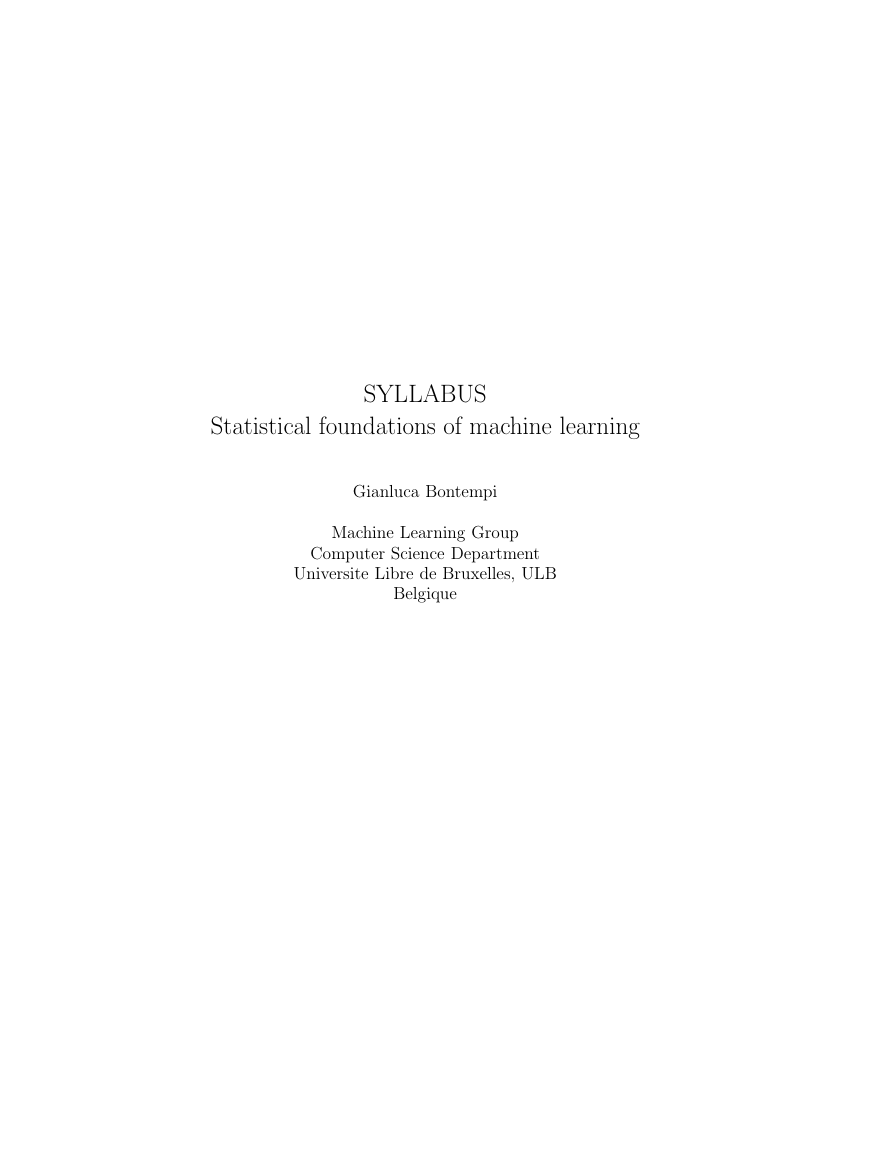

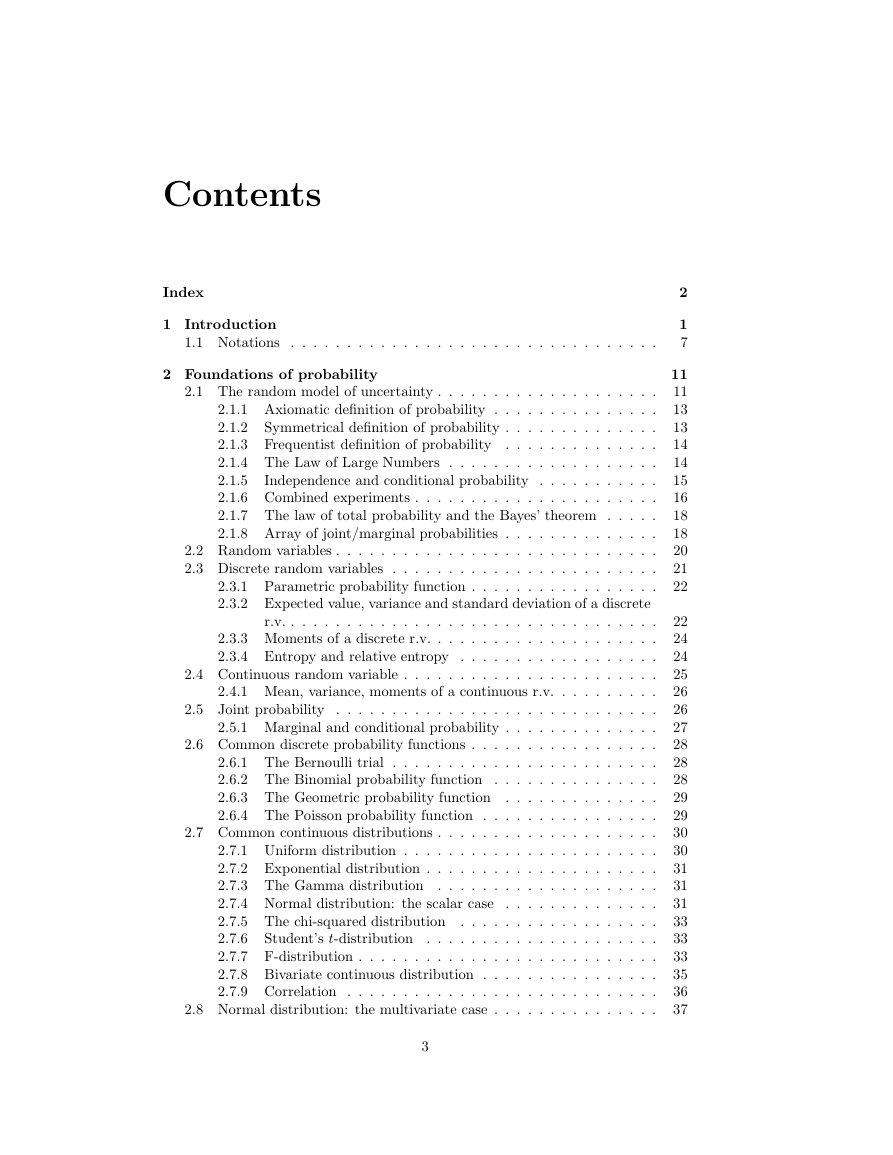

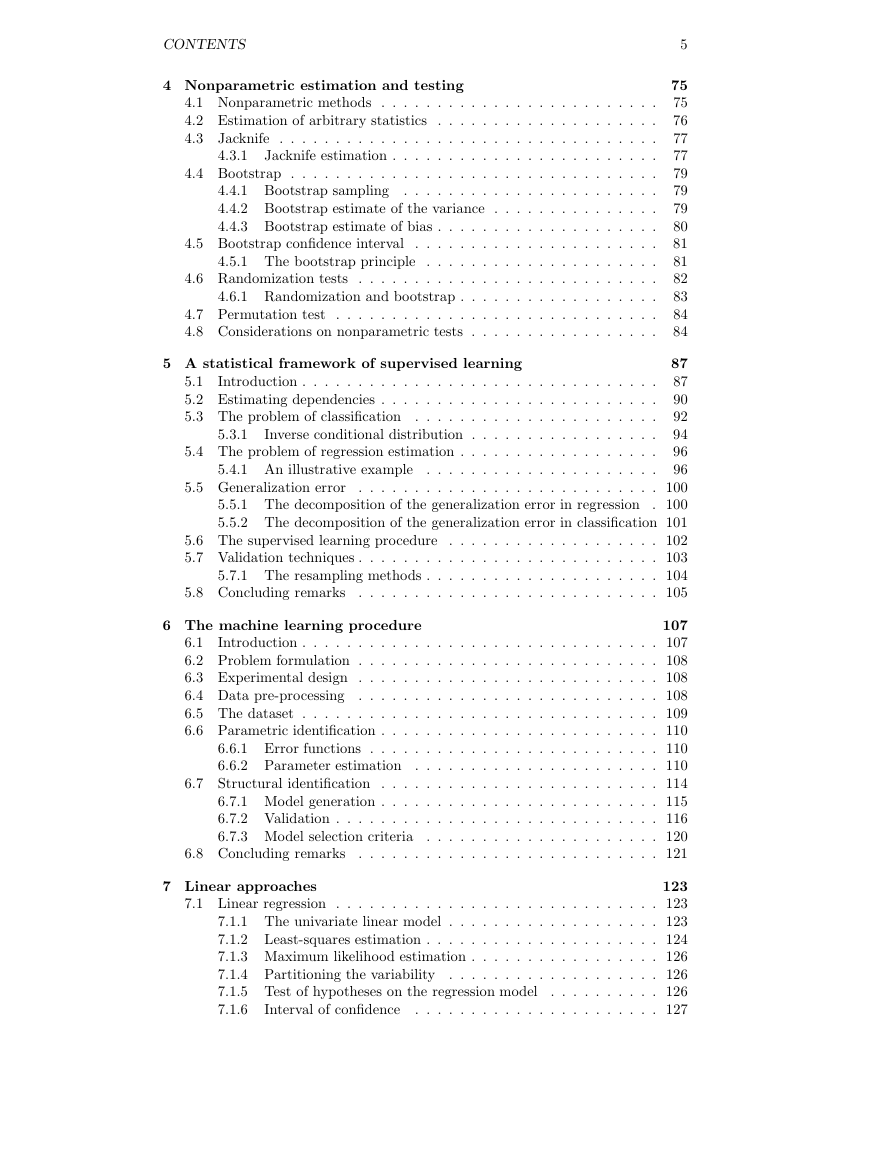
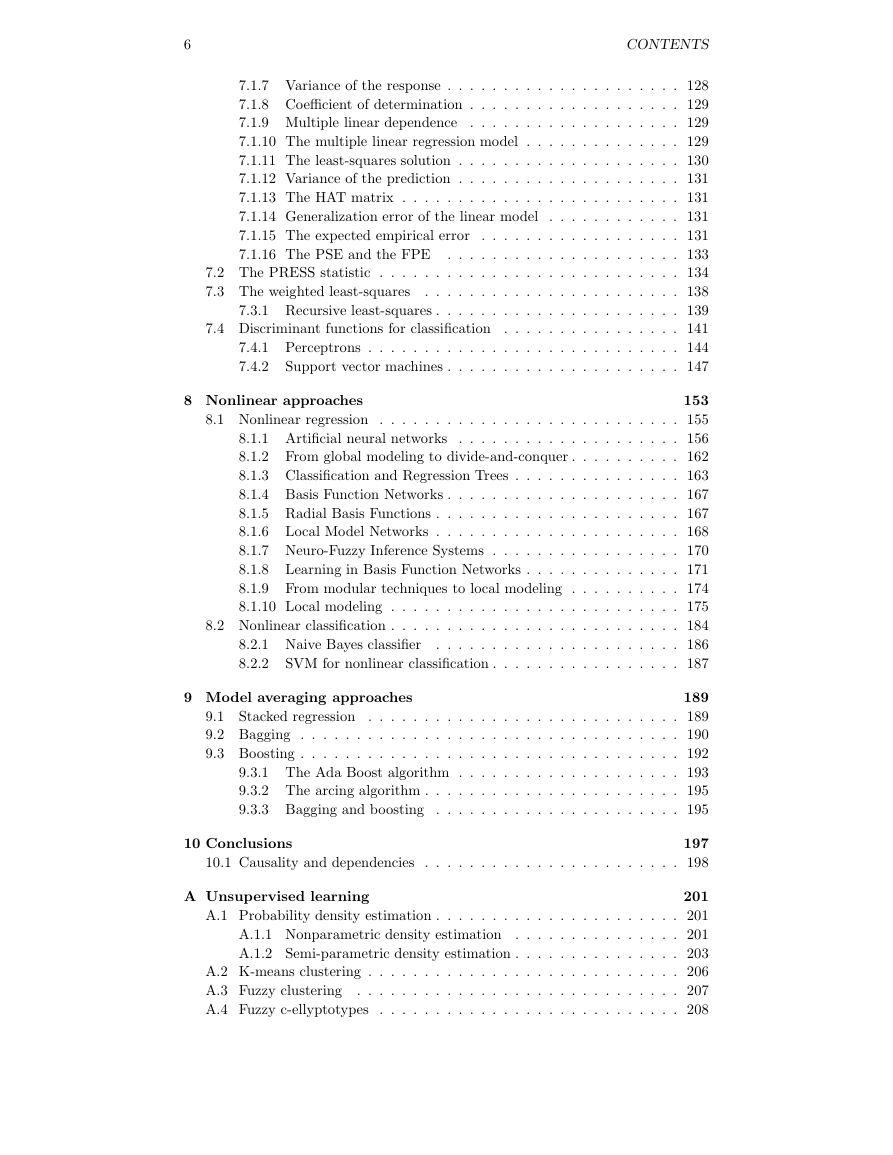
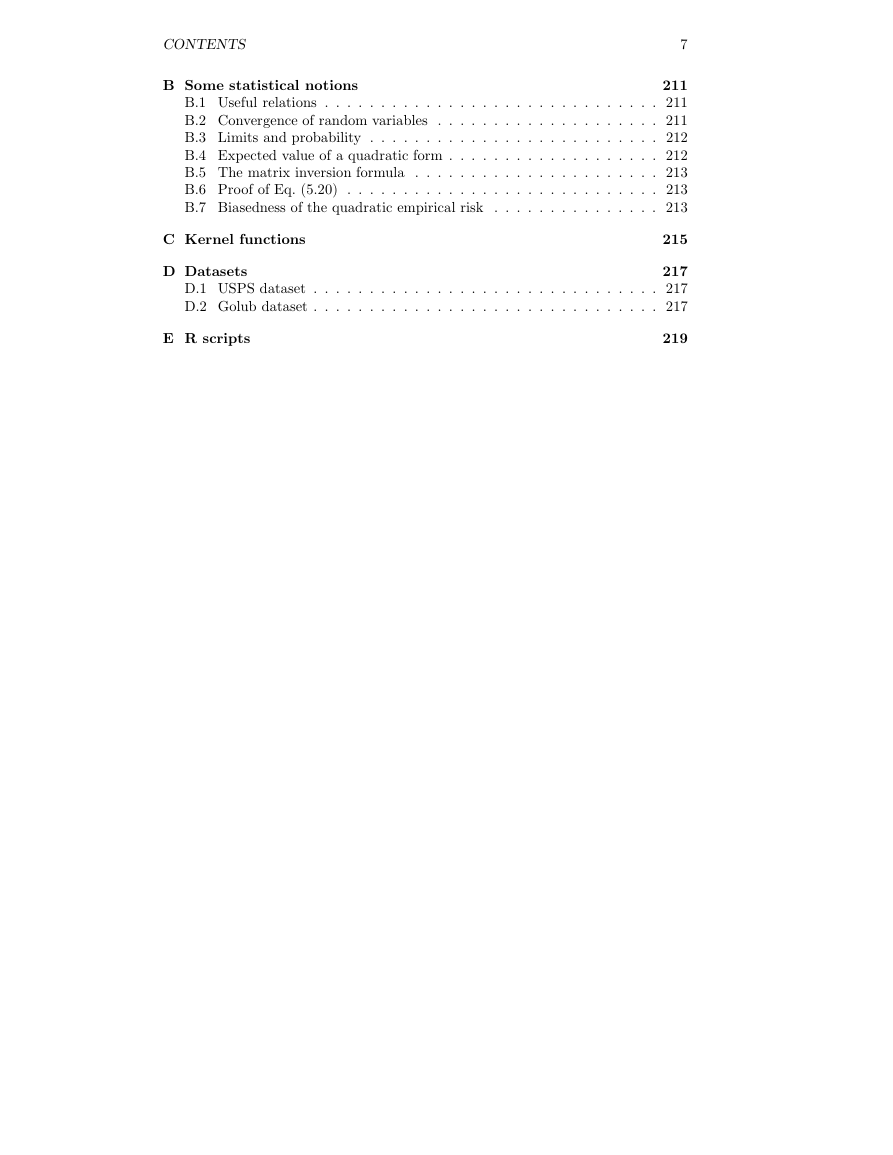









 2023年江西萍乡中考道德与法治真题及答案.doc
2023年江西萍乡中考道德与法治真题及答案.doc 2012年重庆南川中考生物真题及答案.doc
2012年重庆南川中考生物真题及答案.doc 2013年江西师范大学地理学综合及文艺理论基础考研真题.doc
2013年江西师范大学地理学综合及文艺理论基础考研真题.doc 2020年四川甘孜小升初语文真题及答案I卷.doc
2020年四川甘孜小升初语文真题及答案I卷.doc 2020年注册岩土工程师专业基础考试真题及答案.doc
2020年注册岩土工程师专业基础考试真题及答案.doc 2023-2024学年福建省厦门市九年级上学期数学月考试题及答案.doc
2023-2024学年福建省厦门市九年级上学期数学月考试题及答案.doc 2021-2022学年辽宁省沈阳市大东区九年级上学期语文期末试题及答案.doc
2021-2022学年辽宁省沈阳市大东区九年级上学期语文期末试题及答案.doc 2022-2023学年北京东城区初三第一学期物理期末试卷及答案.doc
2022-2023学年北京东城区初三第一学期物理期末试卷及答案.doc 2018上半年江西教师资格初中地理学科知识与教学能力真题及答案.doc
2018上半年江西教师资格初中地理学科知识与教学能力真题及答案.doc 2012年河北国家公务员申论考试真题及答案-省级.doc
2012年河北国家公务员申论考试真题及答案-省级.doc 2020-2021学年江苏省扬州市江都区邵樊片九年级上学期数学第一次质量检测试题及答案.doc
2020-2021学年江苏省扬州市江都区邵樊片九年级上学期数学第一次质量检测试题及答案.doc 2022下半年黑龙江教师资格证中学综合素质真题及答案.doc
2022下半年黑龙江教师资格证中学综合素质真题及答案.doc